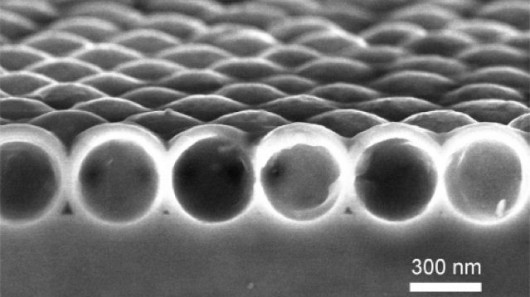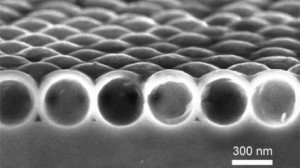By Ben Coxworth
For those unfamiliar with the term, a “whispering gallery” is a round room designed in such a way that sound is carried around its perimeter – this allows a person standing on one side to hear words whispered by a person on the other. Now, scientists from Stanford University have developed a new type of photovoltaic material, that essentially does for sunlight what whispering galleries do for sound. Not only does the material have a structure that circulates light entering it, but it could also result in cheaper, less fragile, and less angle-sensitive solar panels.

The new material consists of tiny hollow spheres, made out of nanocrystalline-silicon. While nanocrystalline-silicon has good electrical efficiency and is able to stand up to the damaging effects of sunlight, is isn’t particularly good at absorbing light – in past attempts at using it for photovoltaics, it has had to be thickly layered, which has in turn resulted in long manufacturing times. That’s where the spheres – known as nanoshells – come into play.
To make the nanoshells, the scientists coated individual balls of silica with silicon, then used hydrofluoric acid to etch away the silica in the center. This left them with the hollow transparent nanoshells.
When sunlight enters one of them, instead of passing straight through, it gets trapped and is circulated several times within the nanoshell. This is a good thing, as the longer the light stays in contact with the nanocrystalline-silicon, the more energy the material can absorb.
This image from a computer simulation shows how waves of light (in red/orange, traveling from the top of image to the bottom) strike a layer of nanoshells and how the light resonates within the shell structure (in red)
In a side-by-side comparison with a flat layer of silicon, a layer of the nanoshells showed “significantly more absorption over a broader spectrum of light.” When the nanoshells were subsequently stacked three layers deep, that improvement went up to 75 percent for certain important ranges of the solar spectrum.
Not only are they more efficient than nanocrystalline-silicon film, but they are easier to make – according to team member Yan Yao, “A micron-thick flat film of solid nanocrystalline-silicon can take a few hours to deposit, while nanoshells achieving similar light absorption take just minutes.” They also require only about one-twentieth the amount of material, which translates into one-twentieth the cost and weight, too. This point could be particularly significant if the technology were used with other, rarer substances, such as tellurium or indium.
Additionally, the efficiency of the nanoshells isn’t greatly affected by their angle to the Sun, so they could be used in locations where an optimal angle isn’t always possible. Finally, layers of them are thin enough that they can stand up to twisting and bending, so they could possibly even be built into items such as sails or clothing.
(Source)

 Follow
Follow